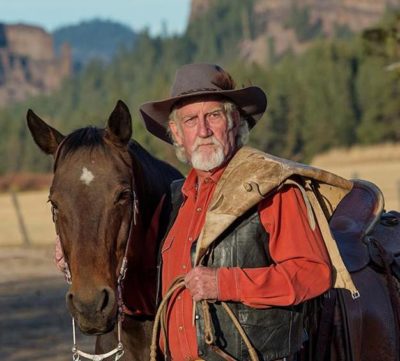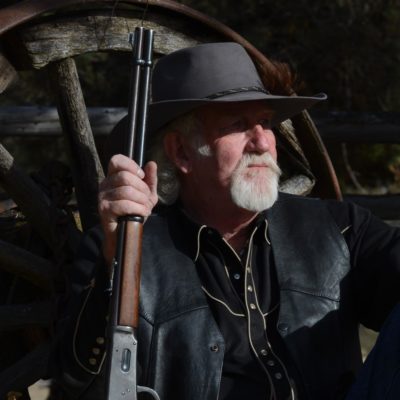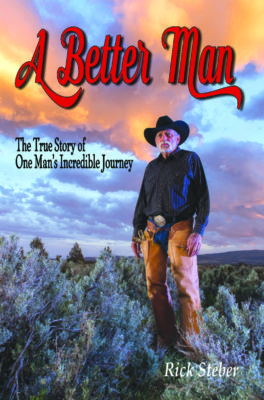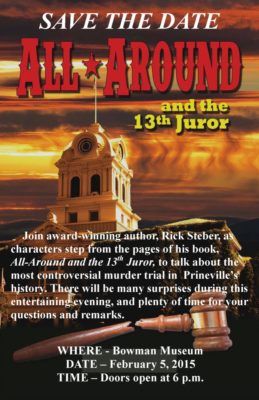
“Rick Steber has given us a fine example of how fiction can tell the grim facts of history in a highly readable novel. His books should be added to the reading lists of students of American history.” – Tony Hillerman
“Rick Steber’s specialty is stories of the West, tales woven from the fabric of the land. His prose deals with people, their relationship with each other and with this place. And his special gift to us is his service as a literary lifeguard—saving stories before folks take them to their graves.” – Jonathan Nicholas – The Oregonian
Meet Rick Steber, the author of more than 40 books with sales of more than a million copies. He has received national acclaim for his writing. His numerous awards include the Western Writers of America Spur Award for Best Western Novel, Western Heritage Award, Benjamin Franklin Award, Mid-America Publishers Award, Oregon Library Association Award, Oregon Literary Arts Award, Independent Publishers Book Award, Indies Award for Excellence, and the USA Best Book Award. Three of his books have been optioned to movie production companies.
In addition to his writing, Rick is an engaging Western personality who has a passion for telling stories of the people and places of the West.
I recently had the pleasure of hearing Rick’s storytelling firsthand when he spoke for the Central Oregon Writers Guild. I witnessed a room filled to capacity go so quiet you could hear a pin drop. Dressed in cowboy duds, western hat and boots, and sporting wavy white hair and a Buffalo Bill goatee, Steber could have been a character from one of his western-flavored novels. I found his manner unpretentious and down-to-earth, which made him immediately likable. Using a modulating tone and facial expressions full of emotion, Rick spun tales of western lore that brought to life an array of eccentric characters.
In June of this year, Rick spoke with me from his home in the timbered foothills of the Ochoco Mountains.
Before we get to your books, Rick, I want to mention how envious your lifestyle is to a writer. You live off the grid, in seclusion, in a cabin you built with your father on a large parcel of land with a couple of dogs. Quiet. Away from distractions. Ideal for an author. Was country life instilled in you by your family and upbringing?
I grew up in Klamath County and always enjoyed the remoteness and the many opportunities to hunt and fish and play in the woods. During summers I hauled hay and worked on ranches. I went away to college, even worked for a few years in Portland, and each time I went home I would discover that another of the old timers I had known growing up had died.
As a kid I had loved to sit around the stove at F.W. Bold and Son’s store, or the gas station, or Ester’s Café, and listen to the old timers spin stories. One day it dawned on me that these old people were taking a lot of history to the grave with them. It was our history and it was being lost, lost for all time. Future generations would never hear the stories, would never have the sense of place that I did.
Then I ran across a quote – just a few words – that forever changed the direction of my life. That quote was – “When an old person dies it is like a library burning down” – and that ignited a passion in me to save as many of those stories as I could.
What authors were your early influences?
I have always loved to read, and it was never a specific genre. I enjoy learning, and being entertained. I read Louis L’Amour, Zane Grey, F. Scott Fitzgerald, Richard Brautigan, Hemingway, and the list goes on and on. And I liked science and astronomy and physics … never did care much for math because it seemed too rigid, too absolute. There is right and there is wrong in math, but I have always enjoyed all the subtle shades of gray between right and wrong.
You did a stint at the mayor’s office in Portland after graduating from college. How did that immersion into politics shape your future outlook?
I was interested in politics as a career, but I was way too damned idealistic for my own good. I thought a person with good ideas, and passion, could make a difference in a political setting. Not true. The machine eats up good men and women and spits them out.

You started your writing career as a newspaper columnist?
True. I started writing a regular column called “Oregon Country,” about Oregon history, which I sold to weekly newspapers. I was still in my 20s at the time and was awestruck the first time my name was in print. I just sat there and stared at it.
To promote it, I rode by horseback to every newspaper in Willamette Valley. I was living in La Grande at the time, and the horse had never seen real traffic before. I remember the first day coming out of Eugene, there wasn’t any way to cross the McKenzie River. A state cop pulled up, and sympathetic to my predicament, told me that Oregon law dictates horseback riders have the right of way. “All you have to do is hold up your hand, and traffic in both directions is required to stop,” the officer told me.
I gave it a shot.
Vroom! Nobody had heard of that law. I decided to lead the horse across the bridge. Some knucklehead kids in a convertible spooked my horse, who was injured after rearing up. I ended up tying my boots on the saddle horn, getting a pair of tennis shoes and leading him the last 250 miles. The Salem Statesman ran a picture of me with the words “Rick Steber, tennis-shoe cowboy.”
The long walk was worth it. The column ended up running in about 57 papers, so I could write one story and get paid 57 times, in theory. That gave me a base income to pursue writing full time. Some of my interviews became the short stories that in turn became part of my 16-volume Tales of the Wild West series.
What inspired you to tackle your first book?
Some of the characters were too large to fit in a short story. Those led to full-length books. One such person was a man who had won the Pendleton Round-Up in 1912. That book is, Wild Horse Rider — a story about outliving your time and usefulness. Another was of a man I heard about who was making and giving away birdhouses. This man explained he’d asked his wife, who was dying of Parkinson’s disease, what he could do while she was waiting for him up in heaven. She answered, “Just one thing. Can you bring the mountain bluebirds back to Oregon?” He said he would. That story became A Promise Given.
You’ve written over 40 books, both fiction and nonfiction. An unsolved murder on the range, the death of an aging rancher, a blind sled dog musher, and the questionable termination of a Native American tribe are just a few of your topics. Are most of your stores based on actual people and real stories?
I write what is of interest to me. I suppose I’m a combination historian, biographer, and storyteller. Most of all, I like to tell a good story that gives the reader a sense of time and place. I’m not big into pouring over a box of papers in the basement of a library. I like to interview people. As I research, the story often times changes as I learn more about the characters. I confess, I’ve interviewed over 20,000 people and collected over one million photographs. I have plenty of research material, but I’m always adding more.
It’s important to me to capture people’s memories and bring them to life for a new generation. I guess I’m like Charlie Russell, the famous western painter. When he was asked why he paints what he paints, he responded, “I’m trying to get it all down before it’s gone.” And I guess that’s what I’m trying to do, get it all down before it’s gone.
Out of all your books, do you have a favorite, or characters that you can’t get out of your head?
My books are, in a way, like my children. I love them all … the story and the characters. Some were easier to raise to adulthood than others. Some gave me a lot of problems and were always in trouble. But I love ‘em all.
I understand you make a point of speaking to 10,000 students a year about the importance of education, reading and saving our history.
I never had anyone come to my school and say that you could be a writer, or a photographer, or a sculptor, or anything else in a creative field. I feel it is important to open students’ minds, especially rural students, to possibilities.
I try to make sure that each student gets one of my books, a book autographed to that student. I’ve had students, years later, thank me and tell me how important it was to them to have that book. One kid said he had gone through some rough years, parents divorced and such, but the one thing he had always held onto was that book.
If a student wants to follow a path in a creative field, I tell them they might not get rich, or become famous, but if you follow your dream and do what you want you will be rich and famous in your own eyes, and let’s face it, that is the most important of all.
Tell us a little about your Tales of the Wild West series of books, which has found a loyal following among classroom teachers. Children enjoy the stories, which are entertaining and fun to read and they learn about real people in history.
That series illustrates the various eras of westward expansions through individual stories of courageous men and women who came west to range stock on the native grass, break fields out of sagebrush flats, reclaim marshlands, clear the forests, build homes and raise families. These folks speak of a time when honest values and good moral character were paramount, when a person could be taken at his word and a handshake guaranteed any agreement. They take pride in making a better life for their families with their personal courage and hard work as well as Mother Nature’s generosity.
What is your writing process? Are you a planner, or free form author?
I am always working on several books at the same time. It takes time to research a book and to arrange that story, and the best way to tell that story, in my head. After the first draft, I get to work on the rewrite. Each book I will probably rewrite 50 times. I tell kids that the first draft is like assembling the bones of a skeleton. And then the second draft, and every subsequent draft, you add something to it. You add the muscles, you add the skin. And it finally gets down to where you’re just adding tiny hairs and freckles and cosmetic things that set your manuscript apart from any others. On a good day, I write about 10 pages.
At the forefront of your accolades is your Western Writers of America Spur Award for Best Western Novel in 2005. You are the only Oregon writer to win this prestigious award. Tell us a little about Buy the Chief A Cadillac.
Buy the Chief A Cadillac is a novel that portrays the ignorance, greed and madness of reservation life during the disastrous 1961 termination of the Klamath Indian Tribe of southern Oregon by the federal government.
Your kind of success is rare. What do you attribute it too?
I’m the only writer I know who makes a living at it. Everybody else has to have some kind of side job. I’m a one-man band. I do it all; research, writing, promoting, and selling. I have my own publishing company, Bonanza Publishing. I release my work exactly the way I want it. I’ve always prided myself on the fact that I never do things the way other writers do. I like my life and lifestyle. Each day is different. For me the best part is having a story in my head and nothing down on paper. I enjoy the challenge of creating and telling a story.
How important is marketing?
Marketing is the key to success. A writer has to be good at marketing, or you best go get a day job. I spend a third of my time researching, a third actually writing, and a third promoting. I tell writers that writing a book is like having a band. You gotta be willing to play all the county fairs.
What’s your advice to aspiring writers?
My advice to writers … never give up, never give in, and you are always right.
When writers tell me they want to publish a book, I tell them that, whether it’s self-published or printed by a big publisher, it’s up to the writer to get out there and promote and sell it. Everybody thinks their book is going to be a best-seller, and they’re going to make a million bucks. They want to print 10,000 copies, or 100,000 copies. I tell those writers they better put some vitamin content in the pages because they might very well be eating most of the run.
If someone unfamiliar with your work wanted to read your books, which ones would you recommend starting with?
I encourage people to read the first paragraph, if that doesn’t inspire them to read more, then put the book down.
What are you currently working on?
My book that will be released this September is titled, Three Little Birds.”
Promo for Three Little Birds
George Hooker’s name is placed on the organ donor list. While he waits, he is given a rescued Canada goose egg that he holds on his chest above his damaged heart. The egg hatches. The gosling imprints on George and he becomes Goose Daddy. In a race against time, the burning question becomes whether or not George will live long enough to see the goose he names Tootie, reach maturity and fly away to join a migrating flock.
Three Little Birds, by award-winning and best-selling author, Rick Steber, weaves an intricate and true story as Tootie outgrows her awkward stages and learns to fly. George’s condition worsens. He is hospitalized, and while he fights to stay alive he clings to the desperate hope a doctor will burst into his room and announce, “We have found you a new heart!” But when that joyful moment does arrive, miles away, a grieving family is accompanying the body of their loved one to the operating room so the healthy organs can be recovered.
Suspenseful, gripping and wistfully compassionate, this emotional story probes the deep and unique bond formed between a man and a wild bird. This is a book you will read and remember each time you look up and see migrating geese in flight. Three Little Birds – A true story of hope.
FOR A COMPLETE LISTING OF RICK STEBER’S BOOKS, VISIT –www.ricksteber.com or call his publishing company at (541) 447-3115.
A few of Rick Steber books…
 A Better Man
A Better Man
Dave Franke might have been content to lead the life of a simple cowboy. But he believed in the American Dream, and he burned with ambition to make his mark in the world. He parlayed building a single house into riding the crest of a building boom in Central Oregon. He owned and operated one of the largest construction companies in the state, and his childhood bride, Peggy, was with him every step of the way. They called themselves Bonnie and Clyde. It was the two of them against the world.
When the Great Recession hit, and interest rates topped 24 percent, they lost everything they had worked so hard to accumulate. Peggy concentrated on raising their four daughters; Dave turned to the bottle. Alcohol became his demon, and that demon ruled his life until one day, out on the broad sweep of the desert, God and Satan had a fistfight over his alcoholic soul. Dave, in a moment of divine intervention, was forced to confront his demon. The demon was strong. The battle of opposing forces raged until Dave was about to lose the one thing he valued most – Peggy’s love – and then he was forced to make the choice to turn his life around. This is a powerful story of profit and loss, of weakness and of strength, a story of failure, and deliverance, and redemption. This is the inspiring story of one man’s incredible journey.
 All-Around and the 13th Juror
All-Around and the 13th Juror
This contemporary non-fiction book reads like pages ripped from a dime novel. All-Around rodeo cowboy, Mac Griffith, is gunned down after a barroom brawl. The shooter is arrested and charged with murder. After a half-century this case is revisited, and this time you, the reader, have the opportunity, and perhaps the responsibility and obligation, to examine the testimony and facts of the case and come to a decision on whether a guilty man was allowed to walk free, or was the man who pulled the trigger acting within his constitutional rights when he stood his ground and took the life of another man? The final decision will be up to you, the 13th juror.
Red White Black
This nonfiction book tells the true story of race and rodeo at the 1911 Pendleton Round-Up. Three men of different skin colors – Jackson Sundown, John Spain, and George Fletcher – are brought together during the finals of the Northwest Saddle Bronc Championship. What happened that September day, the judges’ decision and the reaction of the crowd in the aftermath, forever changed the sport of rodeo, and the way the emerging West was to look at itself. (Winner Beverly Hills Book Award, and Benjamin Franklin Award Winner)
A Promise Given
A true story dealing with the many diverse issues each of us must face at decisive points during our lifetimes. This fast-paced narrative quickly pulls the reader into a Northwest setting and the time period surrounding World War II. Trevor Russell falls in love, and through a lasting marriage spanning nearly six decades, the couple is forced to meet the challenge of having to remove their son from life support, one of them battles a terrible disease and finally they escape to live on a remote ranch in Eastern Oregon. It is here that Trevor makes a promise to his dying wife, promising to bring the mountain bluebirds back to Oregon. He fulfills that promise by building bird houses. (USA Best Book Award)
![230486_130945426983680_313263_n[1]](/wp-content/uploads/230486_130945426983680_313263_n1.jpg) Caught in the Crosshairs
Caught in the Crosshairs
This non-fiction book focuses on the shooting of cowboy Phil Brooks who was riding in the hills of Eastern Oregon and was struck through the heart by a bullet fired from a high-powered rifle. Although an intensive police investigation was launched, nobody has ever stood trial for that murder. (Winner National Indie Excellence Book Awards)
Secrets of the Bull
A contemporary western novel that pits legendary stockman Frank Battle against his family, the federal government and the many outside forces bent on gentrifying his pristine Eastern Oregon valley. “This book is written from the heart and deserves your attention. It should be added to reading lists for all students of American history.” Jim Barnes – IPPY awards director. (Winner of the Independent Publisher Book Award)
Forty Candles on a Cowboy Cake
This fast-paced contemporary western novel is set on the High Desert and is as entertaining, irreverent, sinful and unpredictable as a bunch of drovers hitting town after a long cattle drive. “(Steber) creates wondrous imagery of the country and lifestyle he loves.” (Lee Juillerat – Herald and News)
Buy the Chief a Cadillac
This nationally acclaimed novel portrays the ignorance, greed and madness of reservation life during the disastrous 1961 termination of the Klamath Indian Tribe. “This book should be added to reading lists for all students of American history.” Tony Hillerman (Winner of the Western Writers of America Spur Award)
Buckaroo Heart
Herman Vowell was a cowboy — Betty Torrens a city girl. They found love on a remote cattle ranch until tragedy and the outside world encroached on their happiness. This biography is a tender and true story of eternal love. It is a book that will capture your heart with its charm and power.
Wild Horse Rider
Lew Minor was the best bronc buster in the world, proving it by winning the 1912 World Saddlebronc Championship. But progress soon replaced raw horsepower and in his later years Lew became a forgotten hero, except for one man who refused to allow his legend to die.
New York to Nome
The true story of one of history’s most remarkable expeditions; the 1936-1937 discovery of the Northwest Passage by two head-strong young men, Shell Taylor and Jeff Pope. The Guinness Book of World Records called it the longest canoe trip in history.
No End in Sight
Rachael Scdoris earned international attention by becoming the first legally blind musher to complete the Itidarod sled dog race. This inspirational book portrays her struggle for acceptance, her fight against the limitations imposed by others, and the triumph of making her dreams come true.
Oregon Trail – Last of the Pioneers
Few know that pioneers still traveled the Oregon Trail in covered wagons as late as the 1920’s. This little known era of history is told in the words of the pioneers. (Oregon Literary Award Finalist)
Heartwood
As the tree gains its strength from its heartwood, the West has grown from the strength of character shown by the extraordinary people in this artistic blend of words, photographs and original drawing. (Benjamin Franklin Award Winner)
Round Up
A “roundup” of interesting and rugged western men and women who devoted their lives to working with horses: includes wagon freighters, loggers, cowgirls, bronc riders and much more. (Mid-America Publishers Book Award)
Reviews:
“Steber’s words remind you of Hemingway or Fitzgerald….” (LA Times)
“Rick Steber captures beautifully the mood of the times and of the sturdy people who lived it.” (St. Louis Post-Dispatch)
“The stories spun by Steber prove that history can be not only interesting, but entertaining.” (The Oregonian)
“Steber evokes an era that you need not have lived through to regret its passing.” (Sports Illustrated)
“His prose is deliciously entertaining … I shouted out passages to anyone in earshot. I simply loved it.” (Gannett Westchester Newspapers)